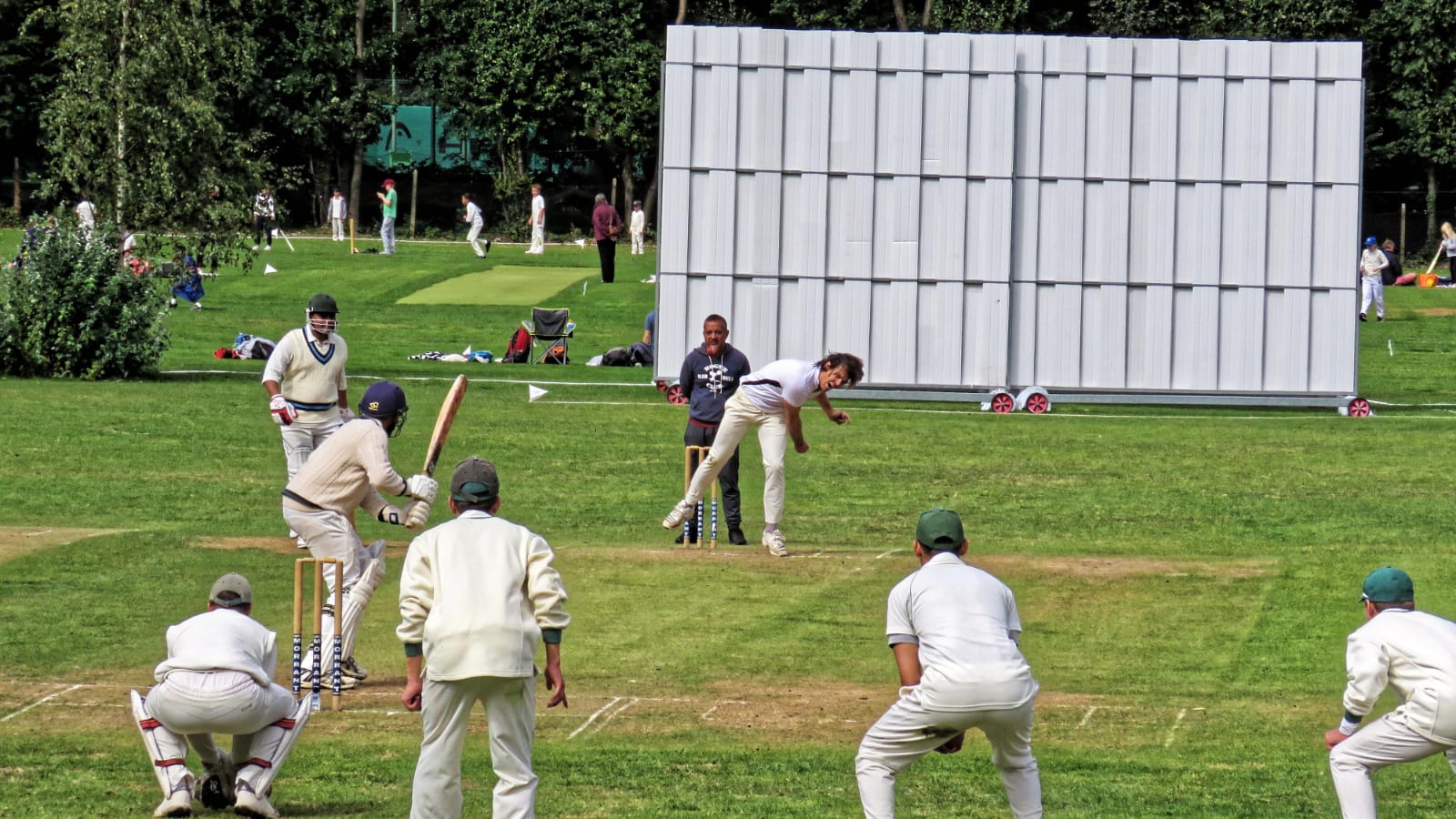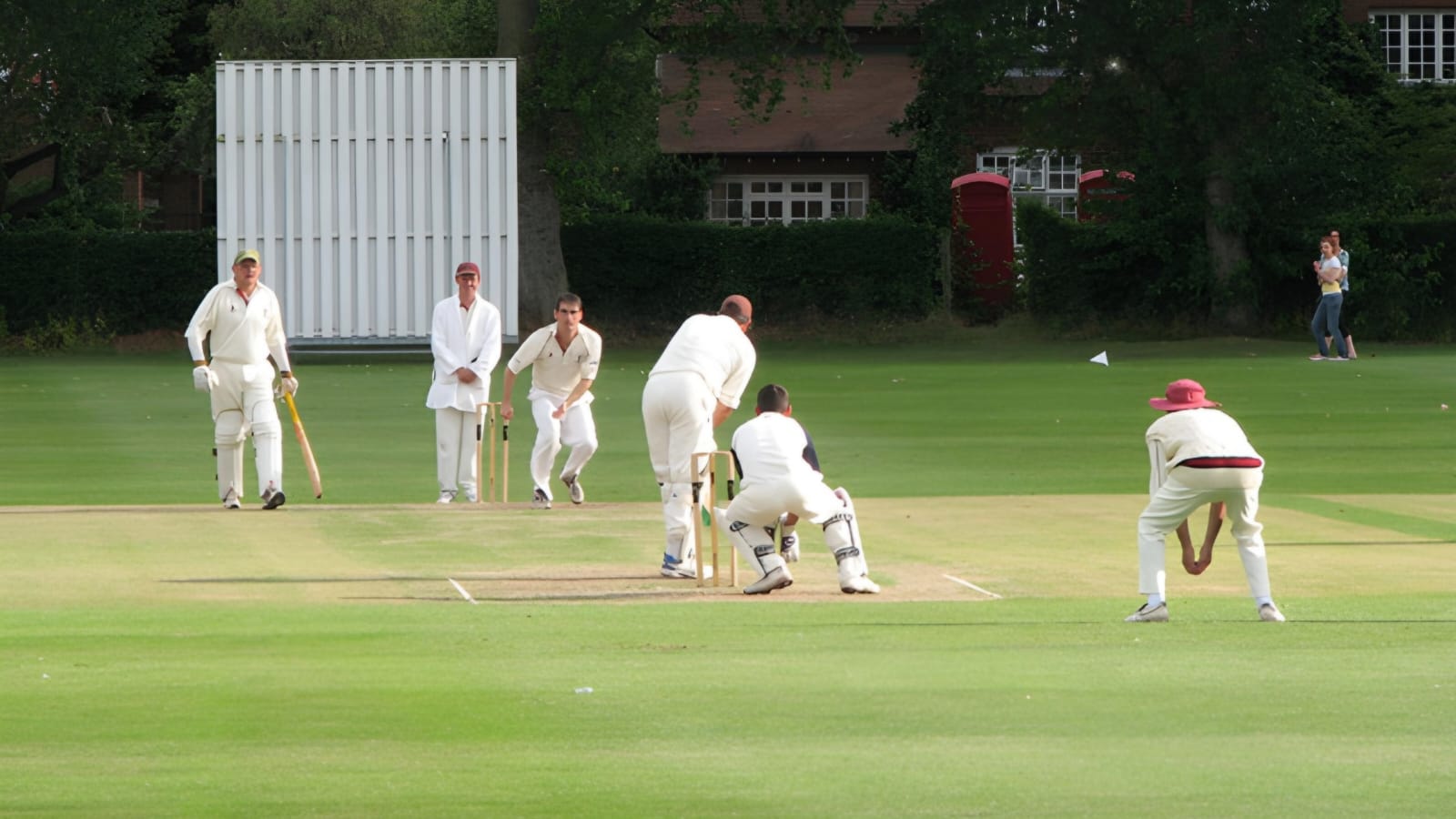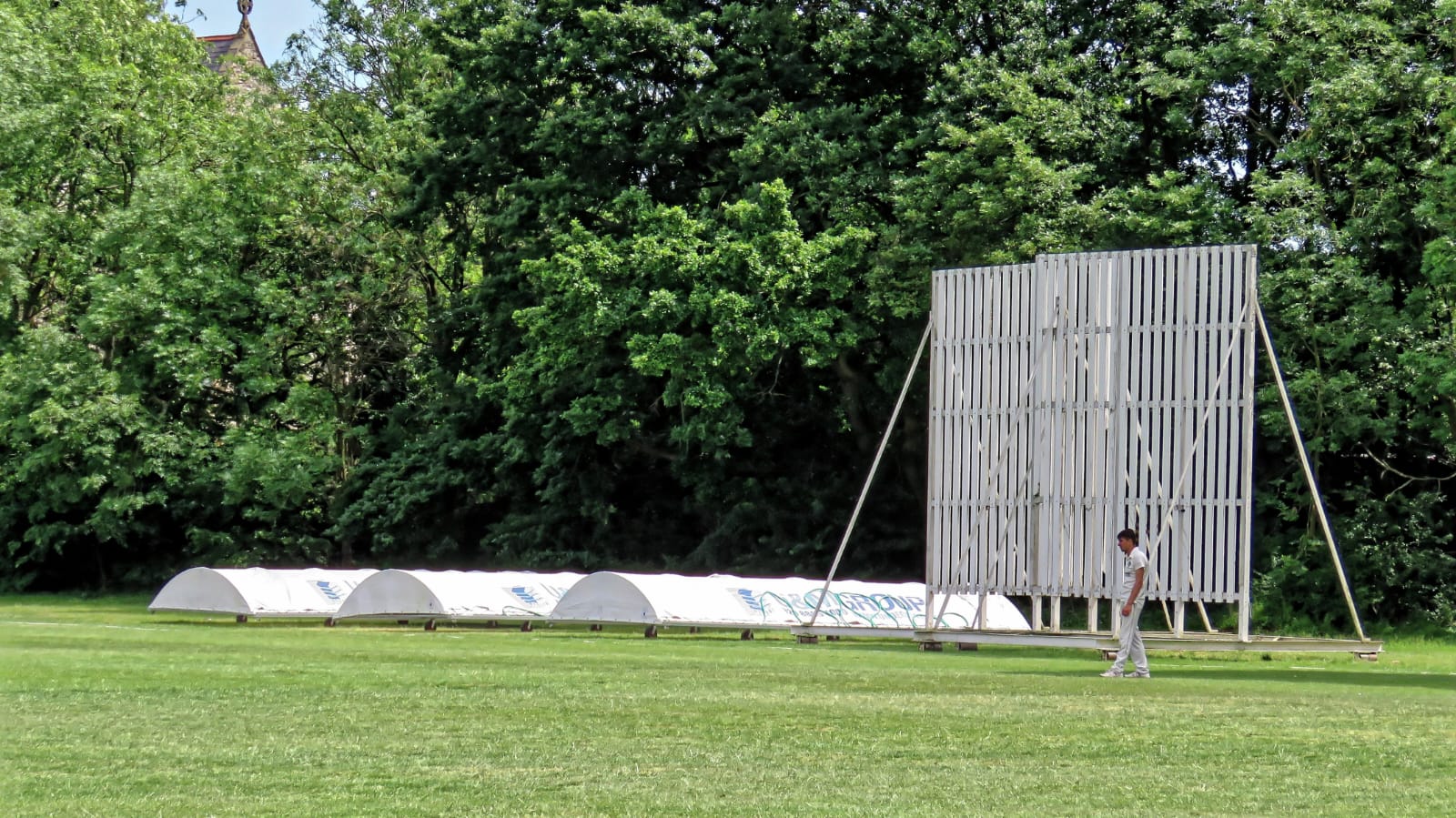Imagine you’re playing cricket. The bowler throws the ball super-fast, like a rocket! Can you see it well enough to hit it, or even dodge it if it’s coming straight for you? That’s where the sight screen comes in – it’s a big wall behind the bowler that helps you see the ball clearly! Let’s explore why sight screens are so important in cricket.

Here is the table for a concise overview of the sight screen’s role in cricket
| Feature | Description |
|---|---|
| Definition | A sight screen is a large screen placed on a cricket field directly behind both wickets beyond the boundary. |
| Purpose | It blocks distractions and makes it easier for the batsman to spot the ball when batting. |
| Material | Usually made of wood, cloth, LED lights, or other such materials. |
| Placement | Positioned at both ends of the wicket so that batsmen have a fair chance of seeing the ball clearly at either end. |
| Color | In limited overs matches with a white ball, the sight screen is usually black or dark. In Test matches with a red or pink ball, it is usually white. |
| Size | The size can vary, but it must be large enough to cover the critical area for the batsman to effectively view the bowler’s delivery. |
1. Definition and Function

What is a Sight Screen?
A sight screen is a large, flat screen positioned at both ends of the cricket pitch, behind the bowler and the batsman. They create a clear contrast between the ball and the background, making it easier for the batsman to see it coming.
The color of the sight screen depends on the type of cricket being played:
- Test Matches: Traditionally red, contrasting well with the red cricket ball used.
- Limited Overs Cricket: Typically black to provide a stark contrast against the white ball used in ODIs and T20s.
Why are Sight Screens Important?
Sight screens play a key role in creating a fair and competitive game for batsmen by:
- Enhanced Visibility: The contrasting colors allow batsmen to track the ball’s trajectory more effectively, judging its line and length to play the right shot.
- Reduced Distractions: Cricket grounds can be visually busy with crowds or advertisements. Sight screens block these out, allowing batsmen to focus solely on the bowler and the ball.
- Fair Play: By providing a consistent visual background, all batsmen have an equal chance to see the ball clearly.
Color Contrast Chart:
Here is a simple chart displaying the two main types of cricket balls (red and white) contrasted against the two common sight screen colors (red and black).

2. Types of Sight Screens
There are several types of sight screens available, each with its own unique features and benefits. Some of the most common types include:
1. Canvas Sight Screens: These are a more budget-friendly option, made from outdoor-grade PVC mesh fabric. They are lightweight and easy to install, making them suitable for both outdoor and indoor cricket fields.
2.Wooden Sight Screens: These are a more traditional option, made from wooden slats painted white or black. They are durable and can withstand the elements, making them a popular choice for cricket clubs.
3. Mesh Sight Screens: These are made from close mesh material, allowing air to flow through the screen. They are less likely to blow over in the wind, making them a popular choice for cricket grounds.
4. Plastic Sight Screens: These are a good investment, providing a long-lasting and durable solution. They are easy to maneuver and install, making them a popular choice for cricket clubs.
5. Reversible Sight Screens: These are made from mesh material and can be flipped to reveal a different color on the other side. They are suitable for cricket grounds that use both red and white balls.
3. Benefits of Sight Screens
Cricket involves a tiny ball being thrown super fast! Batsmen need all the help they can get to see it clearly. That’s where sight screens come in, those big walls behind the bowler and the batsman. Here’s how they benefit the game:

A. Improved Visibility for Batsmen
Imagine playing catch in the park, but the background is full of colorful things. It’s harder to see the ball coming, right? Sight screens act like a big, plain sheet behind the bowler. Since the screen is one color (usually red or black), the bright red ball (test matches) or white ball (limited overs) shows up much clearer. This helps the batsman to track the ball.
B. Reduced Distractions for Batsmen
Crowds can be exciting, but sometimes bright signs or people moving around can distract the batsman. The sight screen acts like a blindfold, blocking these distractions out. The batsman can then concentrate solely on the bowler and the ball coming towards them.
C. Enhanced Spectator Experience
While sight screens are essential for the game, they don’t directly benefit spectators. In fact, sometimes large sight screens might block the view from certain seats.
D. Increased Safety for Players
Sight screens are not directly related to player safety. They focus on helping batsmen see the ball better. Other equipment like helmets and pads are what keep players safe on the field.
4. Installation and Maintenance

A. Installation of sight screens
Installing a cricket sight screen typically involves the following steps:
1. Choose the right location: Identify a suitable location for the sight screen on the cricket pitch, ensuring it is level and secure.
2. Prepare the ground: Clear the area of any debris or obstructions, and ensure the ground is even and firm.
3. Unpack and assemble the sight screen: Carefully unpack the sight screen and its components, such as poles and guy ropes. Assemble the screen according to the manufacturer’s instructions.
4. Secure the poles: Place the poles in the ground, ensuring they are level and secure. Use guy ropes to tie them down, if necessary.
5. Attach the screen: Attach the screen to the poles, ensuring it is securely fastened and level.
6. Adjust and fine-tune: Adjust the screen to ensure it is at the correct height and angle. Fine-tune any adjustments to ensure the screen is stable and secure.
7. Test and inspect: Test the sight screen by gently tugging on it to ensure it is securely fastened and won’t topple over. Inspect the screen for any damage or defects.
It’s recommended to follow the manufacturer’s instructions for specific installation requirements, as different types of sight screens may have unique installation procedures.
Additionally, it’s a good idea to consult with a professional if you’re unsure about the installation process or if you’re dealing with a complex or large sight screen.
B. Maintenance of sight screens
The maintenance of sight screens in cricket is crucial to ensure their longevity and effectiveness. Here are some key points regarding the maintenance of sight screens based on the provided search results:

1. End of Season Maintenance: At the end of the cricket season, it is essential to take steps to protect sight screens from potential damage during the winter months. This includes positioning the sight screens in a sheltered area away from prevailing winds to minimize the risk of damage.
2. Removable Components: Some sight screens have removable components, such as fabric mesh or PVC planks, which can be taken out to reduce wind resistance and prevent damage. This feature allows for easier storage and maintenance of the sight screens.
3. Securing the Frames: Chaining the frames of the sight screens can help reduce movement and prevent damage. Depending on the design and strength of the sight screens, leaning the structure over to lower the screen to the ground can also minimize the impact of wind forces.
4. Safe Handling Practices: When maintaining sight screens, it is important to follow safe manual handling practices to prevent injuries. Having enough helpers to assist with the maintenance tasks ensures the safety of everyone involved
5. Regular Inspection: Regularly inspecting sight screens for any signs of damage, wear, or defects is essential for their upkeep. Addressing any issues promptly can help prolong the lifespan of the sight screens and ensure they remain effective during matches.
By following proper maintenance practices, including end-of-season storage, securing the frames, and regular inspections, cricket clubs and grounds can ensure that their sight screens remain in optimal condition and continue to serve their purpose effectively.
5. What is the standard size of a cricket sight screen?

The standard size of a cricket sight screen can vary depending on the type and material used. However, following sizes are most used in cricket matches:
1. 10ft x 6.5ft (3m x 2m)
2. 12ft x 6.5ft (3.7m x 2m)
3. 24ft x 6.5ft (7.3m x 2m)
4. 4.5m x 4.25m
These sizes mentioned are standard sizes for cricket sight screens, but it’s important to note that the actual size of a sight screen can vary depending on the specific requirements of the cricket ground or the type of cricket being played.
6. What is the price range for different types of cricket sight screens?
The price range for different types of cricket sight screens varies depending on the material, size, and brand. Here’s the information presented in a table:
| Type of Cricket Sight Screen | Price Range in INR | Approximate Price Range in USD |
|---|---|---|
| Canvas Cricket Sight Screen | ₹ 25,000 – ₹ 65,000 | $350 – $900 |
| Mesh Cricket Sight Screen | ₹ 40,000 – ₹ 120,000 | $550 – $1,700 |
| Plastic Cricket Sight Screen | ₹ 50,000 – ₹ 150,000 | $700 – $2,100 |
| Wooden Cricket Sight Screen | ₹ 60,000 – ₹ 200,000 | $850 – $2,800 |
| Reversible Cricket Sight Screen | ₹ 80,000 – ₹ 250,000 | $1,100 – $3,500 |
| Portable Cricket Sight Screen | ₹ 30,000 – ₹ 100,000 | $420 – $1,400 |
| Fixed Cricket Sight Screen | ₹ 100,000 – ₹ 300,000 | $1,400 – $4,200 |
Please note that these prices are approximate and may vary depending on the brand, quality, and location.
7. Low-Cost Alternatives (Jugaad Ideas)
If you don’t have enough money to buy sight screen here are some low-cost “jugaad” ideas for a cricket sight screen:
- White Bedsheets: You can hang white bedsheets on a rope or a wire. Make sure they are tightly stretched and secure.
- Old Doors: If you have any old doors lying around, you can paint them white and prop them up as a sight screen.
- Plywood: You can use large pieces of plywood, paint them white, and set them up as your sight screen.
- White Tarpaulin: A large piece of white tarpaulin can also work as a sight screen. It’s waterproof, so it’s great for outdoor use.
- Recycled Billboards: Sometimes, you can get old billboards for free or at a low cost. You can paint them white and use them as a sight screen.
Remember, the key is to make sure whatever you use is large enough and white enough to provide a good contrast for the cricket ball. Happy playing! 🏏
8. FAQs about Sight Screens
1. What is a sight screen in cricket?
A sight screen is a large, tall screen placed behind the cricket wickets just beyond the pitch boundary, usually attached to the ground using metal poles, frames, or wheels.
2. What is a size (dimensions) of sight screen in cricket?
The size of a sight screen in cricket can vary depending on the type and material used. Standard sizes include 10ft x 6.5ft (3m x 2m), 12ft x 6.5ft (3.7m x 2m), and 24ft x 6.5ft (7.3m x 2m).
3. Why sight screen used in cricket?
Sight screens are used in cricket to help batsmen see the cricket ball more easily by creating a contrast between the ball and the screen. This helps them track the ball and make accurate decisions.
4. What is side screen in cricket?
A side screen in cricket is another term for a sight screen.
5. What is sight in cricket?
Sight in cricket refers to the ability of the batsman to see the ball clearly and track its movement.
6. Is it a side screen or sight screen?
Both terms refer to the same thing – a large, tall screen placed behind the cricket wickets just beyond the pitch boundary.
7. Are the ads on cricket ground real?
Yes, the ads on cricket grounds are real. In some cases, the slats of the sight screen can be flipped to reveal advertising on the other side.
8. What is the danger area in cricket?
The danger area in cricket refers to the area behind the wickets where the ball can hit the batsman if not properly defended.
9. What is a sight screen in cricket IPL?
A sight screen in the Indian Premier League (IPL) is the same as in other cricket matches – a large, tall screen placed behind the cricket wickets just beyond the pitch boundary.
10. Size of sight screen in cricket in meters?
The size of a sight screen in cricket in meters can vary depending on the type and material used, but standard sizes include 3m x 2m, 3.7m x 2m, and 7.3m x 2m.
9. Poll:
- Have you ever been to a cricket match? (Yes/No)
- If yes, did you notice the sight screens behind the bowler and batsman? (Yes/No)
- Do you think sight screens are an important part of cricket equipment? (Yes/No)
10. Cricket Sight Screen Quiz
- What is the main purpose of a sight screen in cricket?
- (a) To protect the batsman from fast bowling
- (b) To create a fair playing surface
- (c) To help batsmen see the ball more clearly
- (d) To display advertisements during matches
- The color of a sight screen in a Test match typically contrasts with what colored ball?
- (a) White
- (b) Black
- (c) Red
- (d) Yellow
- Sight screens are positioned at both ends of the cricket pitch. Where are they NOT located?
- (a) Directly behind the bowler’s end
- (b) In the center of the pitch
- (c) Behind the batsman at the bowler’s end
- (d) Directly behind the batsman at the long-stop boundary
- In addition to improving ball visibility, sight screens also help batsmen by:
- (a) Increasing the distance of the pitch
- (b) Reducing distractions from the crowd and background
- (c) Making the bowling faster
- (d) Providing shade from the sun
- Imagine you’re batting in a cricket match. A plain background behind the bowler would be more helpful than a busy background for:
- (a) Hearing the bowler’s footsteps
- (b) Seeing the ball coming towards you
- (c) Choosing the right batting stance
- (d) Running between the wickets
11. Conclusion
Sight screens are an essential part of cricket equipment. They contribute significantly to a fair game by helping batsmen see the ball clearly and focus on their shots. Now you know why these big screens are such important players (pun intended) on the cricket field!
Cricket Sight Screen Quiz – Answer Key
- (c) To help batsmen see the ball more clearly
- (c) Red
- (c) Behind the batsman at the bowler’s end (Sight screens are positioned behind the bowler and the batsman, not in the center or behind the batsman at the bowler’s end.)
- (b) Reducing distractions from the crowd and background
- (b) Seeing the ball coming towards you
James Paul is a former first-class cricketer and passionate cricket analyst. His decades of experience on the field and his love for the game shape his insights into the strategies and personalities that define world-class cricket.
